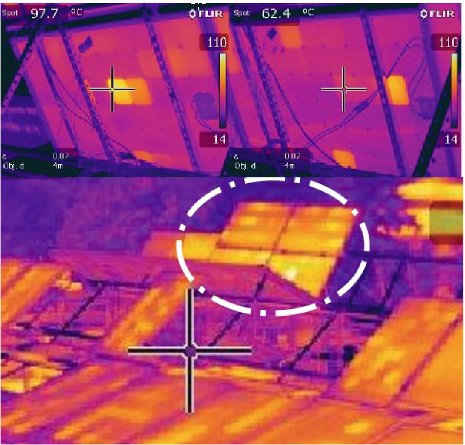October 21, 2015—Solar panels are the beacon of renewable energy, yet they are not getting as much light as they could be. Joshua Pearce from Michigan Technological University and a team from Queen’s University in Canada have found a way to get more sun to shine on the panels and crank up the output by 30 percent or more. The work is published in the Institute of Electrical and Electronics Engineers (IEEE) Journal of Photovoltaics.
“We’re looking at this from a systems perspective,” Pearce says, who is an associate professor of materials science and engineering and electrical and computing engineering. He explains that the research focused on the system rather than individual panels mostly because the current set up for ground-mounted solar panel arrays is “wasting space.”
The iconic flat-faced solar panels installed in large-scale utility solar farms are spaced apart to prevent shading. As the sun shines on a photovoltaic system, sending electricity into the grid, a fair amount of that potential energy is lost as the light hits the ground between rows of panels. The solution is simple, says Pearce: Fill the space with a reflector to bounce sunlight back onto the panels.
Reflectors, or planar concentrators, are not widely used, however.
“Panels are usually warranted for 20 to 30 years,” Pearce says, explaining the warranty only guarantees under certain circumstances. “If you’re putting more sunlight on the panel with a reflector, you will have greater temperature swings and non-uniform illumination, but simple optics makes wrong predictions on the effect.”
Because of the uncertainty with potential hot spots, using reflectors currently voids warranties for solar farm operators. Pearce and his co-authors, found a way to predict the effects using bi-directional reflectance function, or BDRF.
Although the phrase sounds like a nightmare from algebra class, it is actually a set of math equations that people are used to seeing. BDRF is often used in movies and videogames to create more life-like computer generated imagery (CGI) characters and scenes. This works because BDRF equations describe how light bounces off irregular surfaces and predicts how the light will scatter, creating indirect brightening and shadows.
For their solar panel work, Pearce’s team created a BDRF model that could predict how much sunlight would bounce off a reflector and where it would shine on the array. “Real surfaces do not necessarily behave like perfect mirrors, even if they look like it,” Pearce says. “So we applied [BDRF] models to these materials, which scatter the light instead.”
By showing how the reflectors scatter light, the researchers started to take the risk out of using reflectors with solar panels. But even better, the reflectors greatly increase solar system output.
“The mathematics behind this is complicated,” Pearce says, explaining that the team wanted to “validate the predictive model, so the solar industry could start using our equations to design better solar farms.”
So the team took their model to the field and ran an experiment on Canada’s Open Solar Outdoors Testing Field in Kingston, Ontario. The results shined much more light on the problem than predicted by others.
With standard panels, not tilted at the optimum angle for the latitude, the increase in efficiency reached 45 percent. Even with a panel optimally tilted, the efficiency increased by 18 percent and simulations show it could be pushed to 30 percent with better reflectors.
“We expend a lot of blood, sweat and tears to make solar panels as efficient as possible,” Pearce says. “We work so hard to get a fraction of a percent increase on the module level; double digit returns on the systems level was relatively easy.
Such a large increase of efficiency at the system level then could greatly change how solar panels are installed, and with the economic payback, it could even mean major retrofits for existing solar farms.
“Solar farms are already beating antiquated coal technology on cost all over the US,” Pearce says. “There are more solar workers than coal workers now as both in the U.S. and Canada, coal plants are being shut down for cheaper and more environmentally-friendly solar. This just offers to sweeten the economic returns for solar farm investors.”
“The main goal here was to hand the solar farm developers the data needed on a silver platter, which they can then use to modify their farms and crank up their output and revenue by about a third,” Pearce says.
To learn more check out the live tweeted chat with @ProfPearce and @mturesearch. Follow #mtulive for more research events.
Michigan Technological University (www.mtu.edu) is a leading public research university developing new technologies and preparing students to create the future for a prosperous and sustainable world. Michigan Tech offers more than 130 undergraduate and graduate degree programs in engineering; forest resources; computing; technology; business; economics; natural, physical and environmental sciences; arts; humanities; and social sciences.















